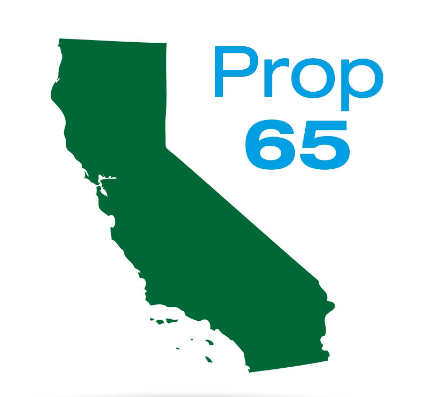California Prop 65 Update
California’s Proposition 65 New Warning Requirements

Starting August 30, 2018, businesses that sell consumer goods to Californians will be subject to new warning requirements.
Through its one-of-a-kind labeling law, California regulates thousands of businesses, whether through e-commerce or retail outlets in the state. The changes to the warning requirements under Proposition 65 (Prop 65) triggered a lot of questions and requests for compliance guarantees and statements by print customers.
Prop 65 was enacted in 1987 and the compliance requirements have not changed. The duty to warn employees and the general public about exposure to over 800 chemicals that are carcinogenic or reproductive hazards above the “no significant risk level” or safe harbor level has been the cornerstone of the regulations.
Warning Requirements
There is an expansion in the types of warnings that must be provided.
- Warning statements are required for consumer products.
- Warning statements are also required if a member of the public enters into a facility and be exposed to a Prop 65 regulated chemical.
- For example, if you have a customer that is performing a press check and this is done in the production area near the equipment where the Prop 65 chemical is being used and released into the air. In this instance, the facility would need to post a warning sign in a prominent location in 72 point type.
The regulation now requires very specific elements identified as to the content. In many instances, a yellow triangle “warning symbol” is required with a statement that the product “can expose” the consumer to the chemical and a link to the Prop 65 website. The old warning had to simply state that the product “contains” a listed chemical.
Below are several examples of product and area warning statements. These are not comprehensive as there are additional warning statements that can be found here.
10-Employee Exemption
There is an exemption from the employee training, consumer warning requirements, and prohibition on discharges into drinking water sources for companies with fewer than 10 employees. This is an important exemption for companies that sell directly to the consumer. However, companies with fewer than 10 employees need to comply with the Proposition 65 warning statements if they sell products to a customer that is not exempt. Many print customers with 10 or more employees sell to consumers in California and will require their suppliers, regardless of exempt status, to comply.
Compliance Steps
The first step is to identify if any components (e.g., substrates, ink, coating, adhesive, etc.) used to manufacture the product(s) being shipped to California contain a Prop 65 chemical. This can be accomplished by reviewing the Safety Data Sheets (SDSs). The information is usually found in either Section 11, Toxicological Information; Section 15, Regulatory Information; or Section 3, Composition. However, this information may also be provided in a different manner such as a separate supplier communication, technical bulletin, or other product-related documents. This is common in situations where an SDS is typically not required to be provided (e.g. substrates, etc.). Contact your supplier if you are uncertain about how this information is being transmitted.
When reviewing the SDSs or other product-related information, it is important to note the concentration of the chemical. If the concentration is omitted, contact the vendor to obtain this information. The most current list of chemicals can be found at https://oehha.ca.gov/proposition-65/proposition-65-list.
If no Prop 65 chemicals are found, no further action is required. This allows a company to easily state its products are in compliance.
If a Prop 65 chemical is found to be in the materials going into the final product, then the following steps can be taken:
- Contact the vendor and request products that do not contain any Prop 65 chemicals. Substituting these products will eliminate any warning statements.
- If the product cannot be substituted, determine if the concentration is above the “no significant risk level” or safe harbor level as identified in the list of regulated chemicals. If the concentration present is less than the threshold, then no further action is required.
- The challenge with this step is that the SDS commonly identifies components on a percentage basis and this does not directly equate into the “no significant risk level” or safe harbor level, which are expressed as micrograms per day. If this is the case or no concentration is provided, contact the vendor and ask them to convert the percentage amount and compare that to the “no significant risk level” or safe harbor level.
- If there is no published “no significant risk level” for a chemical, it assumed to be zero. In this instance contact the vendor and request information on anticipated exposure levels and if the chemical would pose a significant risk to someone who would be exposed to it via finished product.
- If the vendor does not provide any assurances, or the concentrations are greater than the “no significant risk level,” the finished product can be tested to determine the concentration of the Prop 65 chemicals. If none are detected or if they are below the “no significant risk level,” then no warnings are required, and a compliance certification can be provided.
- Given the relatively low concentration that Prop 65 chemicals are found in substrates, inks, coatings, and adhesives, testing the finished product will most likely result in the ability to show that no warning is required.
Here are several examples of product warning statements:
FOR EXPOSURE TO CARCINOGENS
![]() WARNING: This product can expose you to chemicals including [name of one or more chemicals], which is [are] known to the State of California to cause cancer. For more information, go to www.P65Warnings.ca.gov.
WARNING: This product can expose you to chemicals including [name of one or more chemicals], which is [are] known to the State of California to cause cancer. For more information, go to www.P65Warnings.ca.gov.
FOR EXPOSURE TO REPRODUCTIVE TOXINS
![]() WARNING: This product can expose you to chemicals including [name of one or more chemicals], which is [are] known to the State of California to cause birth defects or other reproductive harm. For more information, go to www.P65Warnings.ca.gov.
WARNING: This product can expose you to chemicals including [name of one or more chemicals], which is [are] known to the State of California to cause birth defects or other reproductive harm. For more information, go to www.P65Warnings.ca.gov.
FOR EXPOSURE TO BOTH CARCINOGENS AND REPRODUCTIVE TOXINS
![]() WARNING: This product can expose you to chemicals including [name of one or more listed chemicals], which is [are] known to the State of California to cause cancer, and [name of one or more chemicals], which is [are] known to the State of California to cause birth defects or other reproductive harm. For more information, go to www.P65Warnings.ca.gov.
WARNING: This product can expose you to chemicals including [name of one or more listed chemicals], which is [are] known to the State of California to cause cancer, and [name of one or more chemicals], which is [are] known to the State of California to cause birth defects or other reproductive harm. For more information, go to www.P65Warnings.ca.gov.
Here are several examples of area warning statements:
FOR EXPOSURE TO A SINGLE CARCINOGEN
![]() WARNING: Entering this area can expose you to [name of chemical] from [name of one or more sources of exposure]. [Name of chemical] is known to the State of California to cause cancer. For more information, go to www.P65Warnings.ca.gov.
WARNING: Entering this area can expose you to [name of chemical] from [name of one or more sources of exposure]. [Name of chemical] is known to the State of California to cause cancer. For more information, go to www.P65Warnings.ca.gov.
FOR EXPOSURE TO A SINGLE REPRODUCTIVE TOXIN
![]() WARNING: Entering this area can expose you to [name of chemical] from [name of one or more sources of exposure]. [Name of chemical] is known to the State of California to cause birth defects or other reproductive harm. For more information, go to www.P65Warnings.ca.gov.
WARNING: Entering this area can expose you to [name of chemical] from [name of one or more sources of exposure]. [Name of chemical] is known to the State of California to cause birth defects or other reproductive harm. For more information, go to www.P65Warnings.ca.gov.
FOR EXPOSURE TO CARCINOGENS AND REPRODUCTIVE TOXICANTS
![]() WARNING: Entering this area can expose you to chemicals known to the State of California to cause cancer and birth defects or other reproductive harm, including [name of one or more chemicals known to cause cancer and name of one or more chemicals known to cause birth defects or other reproductive harm], from [name of one or more sources of exposure]. For more information go to www.P65Warnings.ca.gov.
WARNING: Entering this area can expose you to chemicals known to the State of California to cause cancer and birth defects or other reproductive harm, including [name of one or more chemicals known to cause cancer and name of one or more chemicals known to cause birth defects or other reproductive harm], from [name of one or more sources of exposure]. For more information go to www.P65Warnings.ca.gov.
For More Information
In order to assist businesses with compliance, the state has created guidance materials. Included is an overview of the new regulations and links to informative questions and answers. The material can be found at www.p65warnings.ca.gov/new-proposition-65-warnings.




